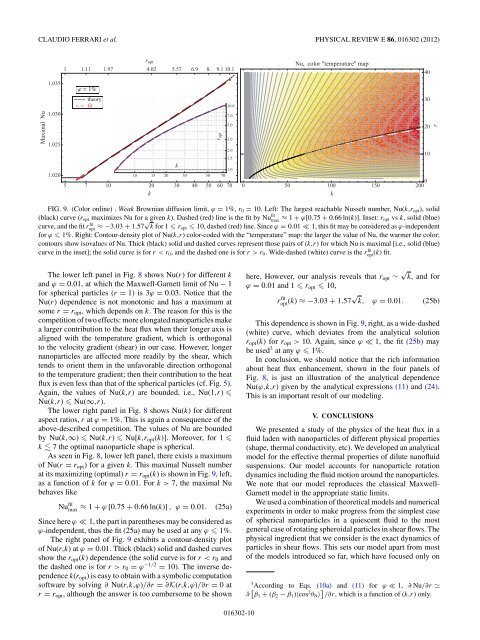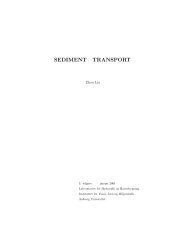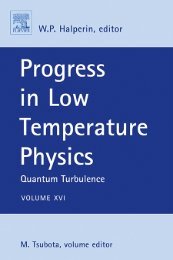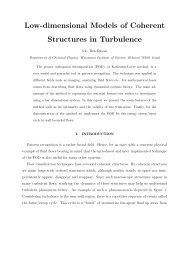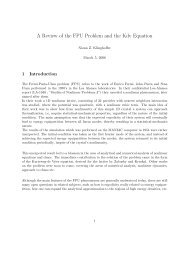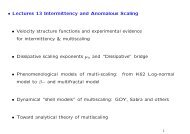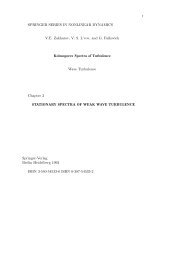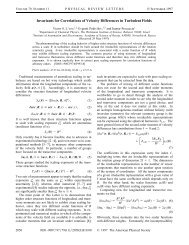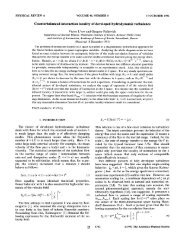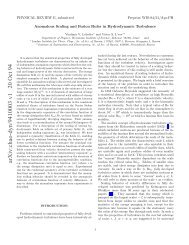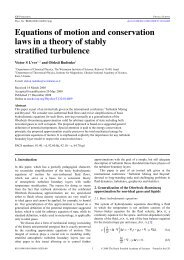Analytical modeling for heat transfer in sheared flows of nanofluids
Analytical modeling for heat transfer in sheared flows of nanofluids
Analytical modeling for heat transfer in sheared flows of nanofluids
Create successful ePaper yourself
Turn your PDF publications into a flip-book with our unique Google optimized e-Paper software.
CLAUDIO FERRARI et al. PHYSICAL REVIEW E 86, 016302 (2012)<br />
Maximal Nu<br />
1.035<br />
1.030<br />
1.025<br />
1.020<br />
1 1.11 1.97<br />
ropt<br />
4.02 5.57 6.9 8. 9.1 10.1<br />
1<br />
theory<br />
fit<br />
10 15 20 30 50 70<br />
5 7 10 20<br />
k<br />
30 40 50 60 70<br />
k<br />
ropt<br />
10.0<br />
7.0<br />
5.0<br />
3.0<br />
2.0<br />
1.5<br />
1.0<br />
Nu, color "temperature" map<br />
0 50 100 150 200 0<br />
FIG. 9. (Color onl<strong>in</strong>e) . Weak Brownian diffusion limit, ϕ = 1%, r0 = 10. Left: The largest reachable Nusselt number, Nu(k,ropt), solid<br />
(black) curve (ropt maximizes Nu <strong>for</strong> a given k). Dashed (red) l<strong>in</strong>e is the fit by Nu fit<br />
max ≈ 1 + ϕ[0.75 + 0.66 ln(k)]. Inset: ropt vs k, solid (blue)<br />
curve, and the fit rfit opt ≈−3.03 + 1.57√k <strong>for</strong> 1 ropt 10, dashed (red) l<strong>in</strong>e. S<strong>in</strong>ce ϕ = 0.01 ≪ 1, this fit may be considered as ϕ-<strong>in</strong>dependent<br />
<strong>for</strong> ϕ 1%. Right: Contour-density plot <strong>of</strong> Nu(k,r) color-coded with the “temperature” map: the larger the value <strong>of</strong> Nu, the warmer the color;<br />
contours show isovalues <strong>of</strong> Nu. Thick (black) solid and dashed curves represent those pairs <strong>of</strong> (k,r) <strong>for</strong> which Nu is maximal [i.e., solid (blue)<br />
curve <strong>in</strong> the <strong>in</strong>set]; the solid curve is <strong>for</strong> rr0. Wide-dashed (white) curve is the rfit opt (k) fit.<br />
The lower left panel <strong>in</strong> Fig. 8 shows Nu(r) <strong>for</strong> different k<br />
and ϕ = 0.01, at which the Maxwell-Garnett limit <strong>of</strong> Nu − 1<br />
<strong>for</strong> spherical particles (r = 1) is 3ϕ = 0.03. Notice that the<br />
Nu(r) dependence is not monotonic and has a maximum at<br />
some r = ropt, which depends on k. The reason <strong>for</strong> this is the<br />
competition <strong>of</strong> two effects: more elongated nanoparticles make<br />
a larger contribution to the <strong>heat</strong> flux when their longer axis is<br />
aligned with the temperature gradient, which is orthogonal<br />
to the velocity gradient (shear) <strong>in</strong> our case. However, longer<br />
nanoparticles are affected more readily by the shear, which<br />
tends to orient them <strong>in</strong> the unfavorable direction orthogonal<br />
to the temperature gradient; then their contribution to the <strong>heat</strong><br />
flux is even less than that <strong>of</strong> the spherical particles (cf. Fig. 5).<br />
Aga<strong>in</strong>, the values <strong>of</strong> Nu(k,r) are bounded, i.e., Nu(1,r) <br />
Nu(k,r) Nu(∞,r).<br />
The lower right panel <strong>in</strong> Fig. 8 shows Nu(k) <strong>for</strong> different<br />
aspect ratios, r at ϕ = 1%. This is aga<strong>in</strong> a consequence <strong>of</strong> the<br />
above-described competition. The values <strong>of</strong> Nu are bounded<br />
by Nu(k,∞) Nu(k,r) Nu[k,ropt(k)]. Moreover, <strong>for</strong> 1 <br />
k 7 the optimal nanoparticle shape is spherical.<br />
As seen <strong>in</strong> Fig. 8, lower left panel, there exists a maximum<br />
<strong>of</strong> Nu(r = ropt) <strong>for</strong> a given k. This maximal Nusselt number<br />
at its maximiz<strong>in</strong>g (optimal) r = ropt(k) is shown <strong>in</strong> Fig. 9,left,<br />
as a function <strong>of</strong> k <strong>for</strong> ϕ = 0.01. For k>7, the maximal Nu<br />
behaves like<br />
Nu fit<br />
max ≈ 1 + ϕ [0.75 + 0.66 ln(k)] , ϕ = 0.01. (25a)<br />
S<strong>in</strong>ce here ϕ ≪ 1, the part <strong>in</strong> parentheses may be considered as<br />
ϕ-<strong>in</strong>dependent, thus the fit (25a) may be used at any ϕ 1%.<br />
The right panel <strong>of</strong> Fig. 9 exhibits a contour-density plot<br />
<strong>of</strong> Nu(r,k)atϕ = 0.01. Thick (black) solid and dashed curves<br />
show the ropt(k) dependence (the solid curve is <strong>for</strong> rr0 = ϕ−1/2 = 10). The <strong>in</strong>verse dependence<br />
k(ropt) is easy to obta<strong>in</strong> with a symbolic computation<br />
s<strong>of</strong>tware by solv<strong>in</strong>g ∂ Nu(r,k,ϕ)/∂r = ∂K(r,k,ϕ)/∂r = 0at<br />
r = ropt, although the answer is too cumbersome to be shown<br />
016302-10<br />
k<br />
here. However, our analysis reveals that ropt ∼ √ k, and <strong>for</strong><br />
ϕ = 0.01 and 1 ropt 10,<br />
40<br />
30<br />
20<br />
10<br />
r<br />
r fit<br />
opt (k) ≈−3.03 + 1.57√ k, ϕ = 0.01. (25b)<br />
This dependence is shown <strong>in</strong> Fig. 9, right, as a wide-dashed<br />
(white) curve, which deviates from the analytical solution<br />
ropt(k) <strong>for</strong>ropt > 10. Aga<strong>in</strong>, s<strong>in</strong>ce ϕ ≪ 1, the fit (25b) may<br />
be used 3 at any ϕ 1%.<br />
In conclusion, we should notice that the rich <strong>in</strong><strong>for</strong>mation<br />
about <strong>heat</strong> flux enhancement, shown <strong>in</strong> the four panels <strong>of</strong><br />
Fig. 8, is just an illustration <strong>of</strong> the analytical dependence<br />
Nu(ϕ,k,r) given by the analytical expressions (11) and (24).<br />
This is an important result <strong>of</strong> our <strong>model<strong>in</strong>g</strong>.<br />
V. CONCLUSIONS<br />
We presented a study <strong>of</strong> the physics <strong>of</strong> the <strong>heat</strong> flux <strong>in</strong> a<br />
fluid laden with nanoparticles <strong>of</strong> different physical properties<br />
(shape, thermal conductivity, etc). We developed an analytical<br />
model <strong>for</strong> the effective thermal properties <strong>of</strong> dilute nan<strong>of</strong>luid<br />
suspensions. Our model accounts <strong>for</strong> nanoparticle rotation<br />
dynamics <strong>in</strong>clud<strong>in</strong>g the fluid motion around the nanoparticles.<br />
We note that our model reproduces the classical Maxwell-<br />
Garnett model <strong>in</strong> the appropriate static limits.<br />
We used a comb<strong>in</strong>ation <strong>of</strong> theoretical models and numerical<br />
experiments <strong>in</strong> order to make progress from the simplest case<br />
<strong>of</strong> spherical nanoparticles <strong>in</strong> a quiescent fluid to the most<br />
general case <strong>of</strong> rotat<strong>in</strong>g spheroidal particles <strong>in</strong> shear <strong>flows</strong>. The<br />
physical <strong>in</strong>gredient that we consider is the exact dynamics <strong>of</strong><br />
particles <strong>in</strong> shear <strong>flows</strong>. This sets our model apart from most<br />
<strong>of</strong> the models <strong>in</strong>troduced so far, which have focused only on<br />
3 Accord<strong>in</strong>g to Eqs. (10a) and (11) <strong>for</strong> ϕ ≪ 1, ∂ Nu/∂r <br />
∂ β1 + (β2 − β1)〈cos 2 θN〉 /∂r, which is a function <strong>of</strong> (k,r) only.


